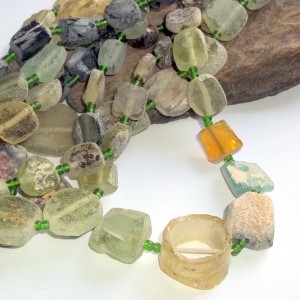Although forms of glass were produced over 2000 years before the founding of Rome, it was the economic and industrial might of the Roman Empire that made glass popular and available throughout the known world.
With the discovery of glassblowing in Palestine around the first century BC glasswork quickly spread and less than 200 years later could be purchased in every corner of the Empire.
The combination of an abundance of source material – mainly sand – as well as being the crossroads of trade and commerce in the Mediterranean made Palestine ideally suited to become the industrial capital of glass making in the ancient world.
Quickly, the glass makers began to mix different materials into the glass to change the color from the distinctive “aqua” of untreated glass to mirror all the colors of the rainbow. For example, using Magnemium would create a brilliant purple color while adding lead and Antimony creates a lovely yellow. View a complete guide to Roman Glass colors.
Uses of Roman Glass
Initially glass was a luxury only available to very wealthy but as highly-skill glass blowers began to pour into Rome and production grew, glass objects became more affordable middle class families.
As the popularity of glass work grew and became accessible to the average citizen, it became indispensible in virtually every aspect of day-to-day Roman life.
• Goblets and urns for holding or drinking water and more adult beverages
• Basins and bowls used for washing
• Containers for storing perishable fruits and vegetables as well as vessels for dispensing oils and sauces
• Small vials for holding cosmetics, perfumes and ointments
• Glass jewelry for more affluent citizens (Yes, your Roman Glass Jewelry might actually be part of a 2000 year old piece of jewelry!)
In fact, glass became so abundant throughout the Empire that Trimalchio, a character in the famous Roman novel The Satyricon remarked that, even though they were more fragile, he would prefer glass vessels to gold ones because “These days, they are cheap.”
Within a few decades glass work began to move from the utilitarian to the artistic as glass-blowers experimented with more sophisticated techniques in order to produce glass objects in the shape of animals, trees and even people.
Roman Glass In The Modern World
Today most of the Roman Glass to be found in the world originates in Israel and Palestine; where the same sands that were used in the creation of the glass now help preserve it for centuries.
Whether unearthed by archeological digs or construction projects that turn up Roman ruins the glass quickly finds it’s way into the hands of collectors who sift, select and polish the artifacts into gleaming baubles.
These ancient treasures are then passed to modern-day artisans that turn them into beautiful necklaces, earrings and other jewelry so even thousands of years later we can enjoy on of man’s earliest and finest inventions.


Leave a reply